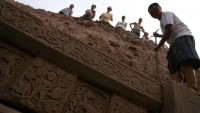Main Coffin From Haihunhou's Tomb Moved to Laboratory for Research
| Nicky West | | Jan 15, 2016 05:18 PM EST |
(Photo : Getty Images/ Xinhua News Agency / Contributor) Haihunhou's burial ground is considered the most complete cemetery from the Western Han Dynasty.
The main coffin discovered in the cemetery of Haihunhou in Nanchang, the capital of East China's Jiangxi province last year, has reportedly been transferred to a laboratory for further archeological study.
The cemetery, which dates back to the Western Han Dynasty (206 BC- 25 AD), covers more than 40,000 square meters and contains eight tombs as well as a chariot burial site built within walls that stretch for more than 900 meters.
Like Us on Facebook
At the time of discovery, the team of archeologists also found ten tonnes of Wuzhu bronze coins as well as 10,000 other gold, silver and copper items. They additionally unearthed jade articles, wooden tablets and bamboo slips.
Xin Liang of the Chinese National Museum said that the next stage of the archeological work includes unearthing items that have been locked at the central mausoleum.
Meanwhile, archeologists have long suspected that the main tomb is that of Liu He, the grandson of Emperor Wu -- one of the greatest rulers of the Han Dynasty.
"We're moving it to a laboratory for further research and DNA testing to see if Liu He is in fact the one laid to rest in the main coffin." said Liang.
Liu He was given the title "Haihunhou" after he was deposed as China's Emperor after only ruling for less than 30 days. He was apparently dethroned by the Royal clan due to his lack of talent and morals.
The site is considered the most complete cemetery from the Western Han Dynasty.
©2015 Chinatopix All rights reserved. Do not reproduce without permission
EDITOR'S PICKS
-

Did the Trump administration just announce plans for a trade war with ‘hostile’ China and Russia?
-

US Senate passes Taiwan travel bill slammed by China
-

As Yan Sihong’s family grieves, here are other Chinese students who went missing abroad. Some have never been found
-

Beijing blasts Western critics who ‘smear China’ with the term sharp power
-

China Envoy Seeks to Defuse Tensions With U.S. as a Trade War Brews
-

Singapore's Deputy PM Provides Bitcoin Vote of Confidence Amid China's Blanket Bans
-

China warns investors over risks in overseas virtual currency trading
-

Chinese government most trustworthy: survey
-

Kashima Antlers On Course For Back-To-Back Titles
MOST POPULAR
LATEST NEWS
Zhou Yongkang: China's Former Security Chief Sentenced to Life in Prison

China's former Chief of the Ministry of Public Security, Zhou Yongkang, has been given a life sentence after he was found guilty of abusing his office, bribery and deliberately ... Full Article
TRENDING STORY

China Pork Prices Expected to Stabilize As The Supplies Recover

Elephone P9000 Smartphone is now on Sale on Amazon India

There's a Big Chance Cliffhangers Won't Still Be Resolved When Grey's Anatomy Season 13 Returns

Supreme Court Ruled on Samsung vs Apple Dispute for Patent Infringement

Microsoft Surface Pro 5 Rumors and Release Date: What is the Latest?













